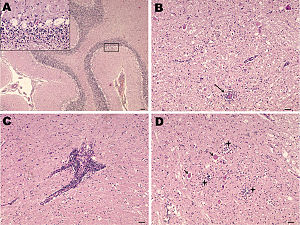Louping ill virus
| Louping ill | |
|---|---|
 |
|
| Nonsuppurative encephalitis in goat affected by louping ill. A) Cerebellum with necrosis of Purkinje cells. Hematoxylin and eosin (H&E) stain; scale bar = 100 µm. Inset: necrosis of Purkinje cells. H&E stain; scale bar = 20 µm. B) Midbrain. Area of neurophagia (arrow) surrounded by microglial cells. Necrosis of neurons can be also seen. H&E stain; scale bar = 50 µm. C) Lymphoid perivascular cuff in midbrain. H&E stain; scale bar = 50 µm. D) Spinal cord, gray matter. Focal microgliosis (crosses) and neurons undergoing necrosis (arrows). H&E stain; scale bar = 50 µm. | |
| Classification and external resources | |
| Specialty | infectious disease |
| ICD-10 | A84.8 |
| ICD-9-CM | 063.1 |
| DiseasesDB | 7591 |
| MeSH | D008146 |
| Louping ill virus | |
|---|---|
| Virus classification | |
| Group: | Group IV ((+)ssRNA) |
| Family: | Flaviviridae |
| Genus: | Flavivirus |
| Species: | Louping ill virus |
Louping-ill (also known as Ovine Encephalomyelitis, Infectious Encephalomyelitis of Sheep, Trembling-ill) is an acute viral disease primarily of sheep that is characterized by a biphasic fever, depression, ataxia, muscular incoordination, tremors, posterior paralysis, coma, and death. Louping-ill is a tick-transmitted disease whose occurrence is closely related to the distribution of the primary vector, the sheep tick Ixodes ricinus. It also causes disease in red grouse, and can affect humans. The name 'louping-ill' is derived from an old Scottish word describing the effect of the disease in sheep whereby they 'loup' or spring into the air.
Louping ill is caused by RNA virus called Louping ill virus. Louping ill virus belongs to genus Flavivirus, family Flaviviridae.
There are four subtypes: British, Irish, Spanish and Turkish.
According to a ProMED article, disease in sheep has been controlled in the UK by a vaccine (ATCvet code: QI04AA01), originally developed by Scotland's Moredun Research Institute by Prof John Russell Greig. In 2009, however, a shortage of vaccine combined with an increase in the number of ticks found in sheep pasture areas cause an increased risk of this disease.
...
Wikipedia
